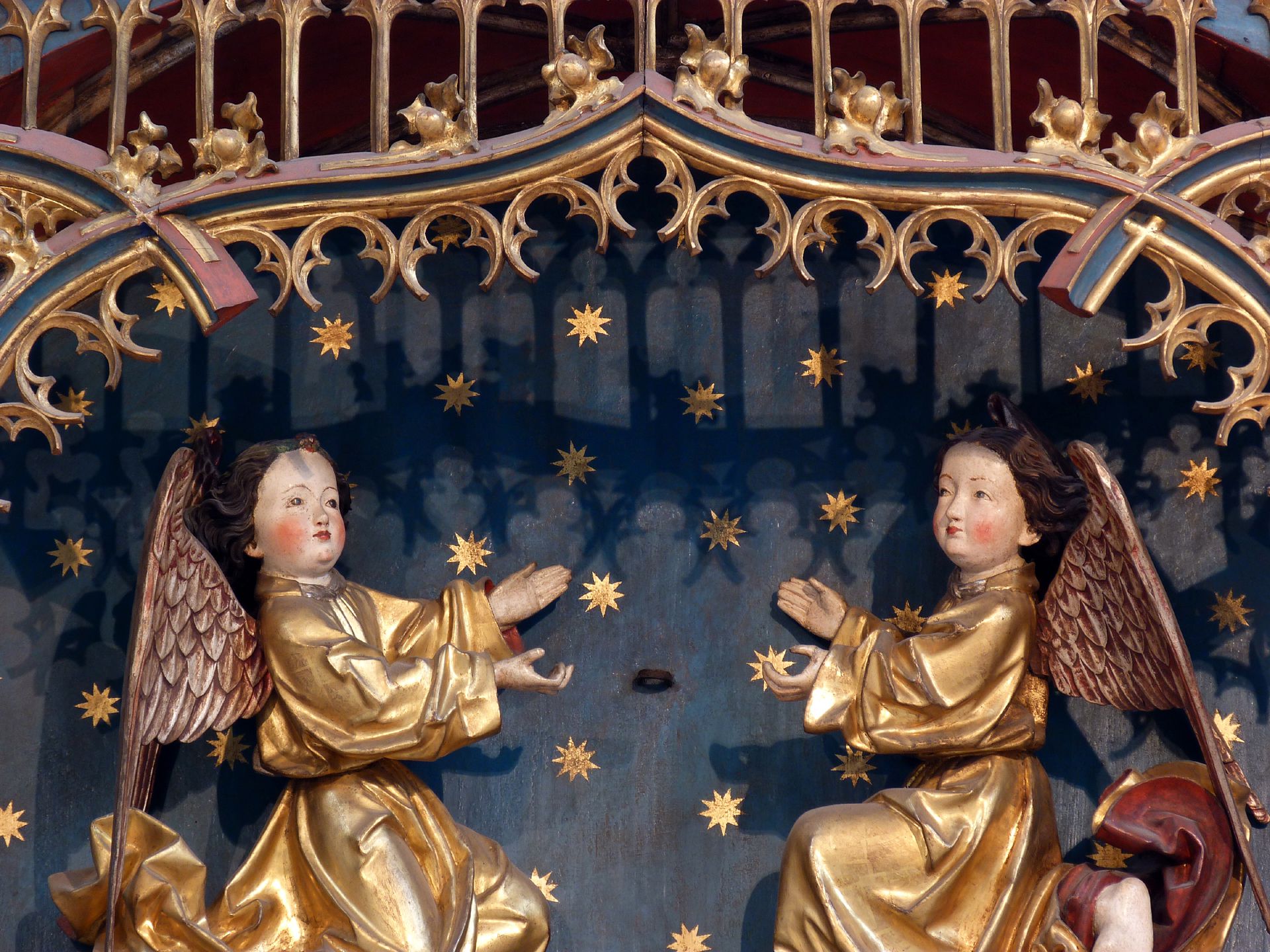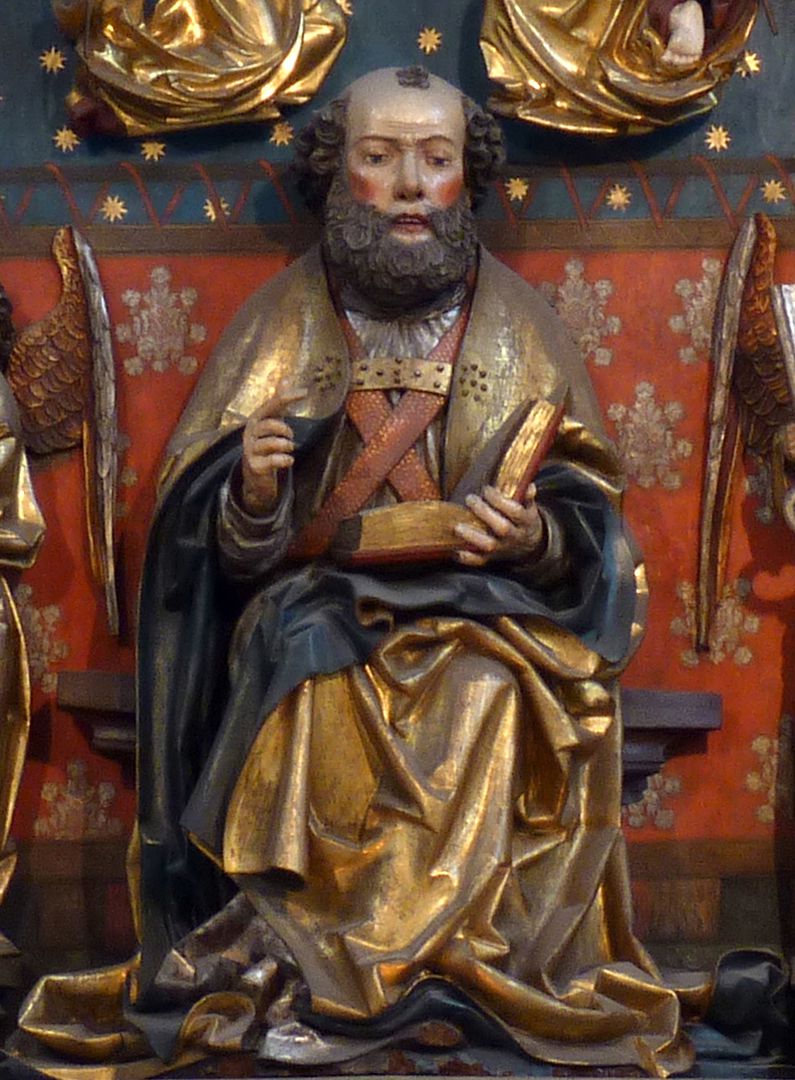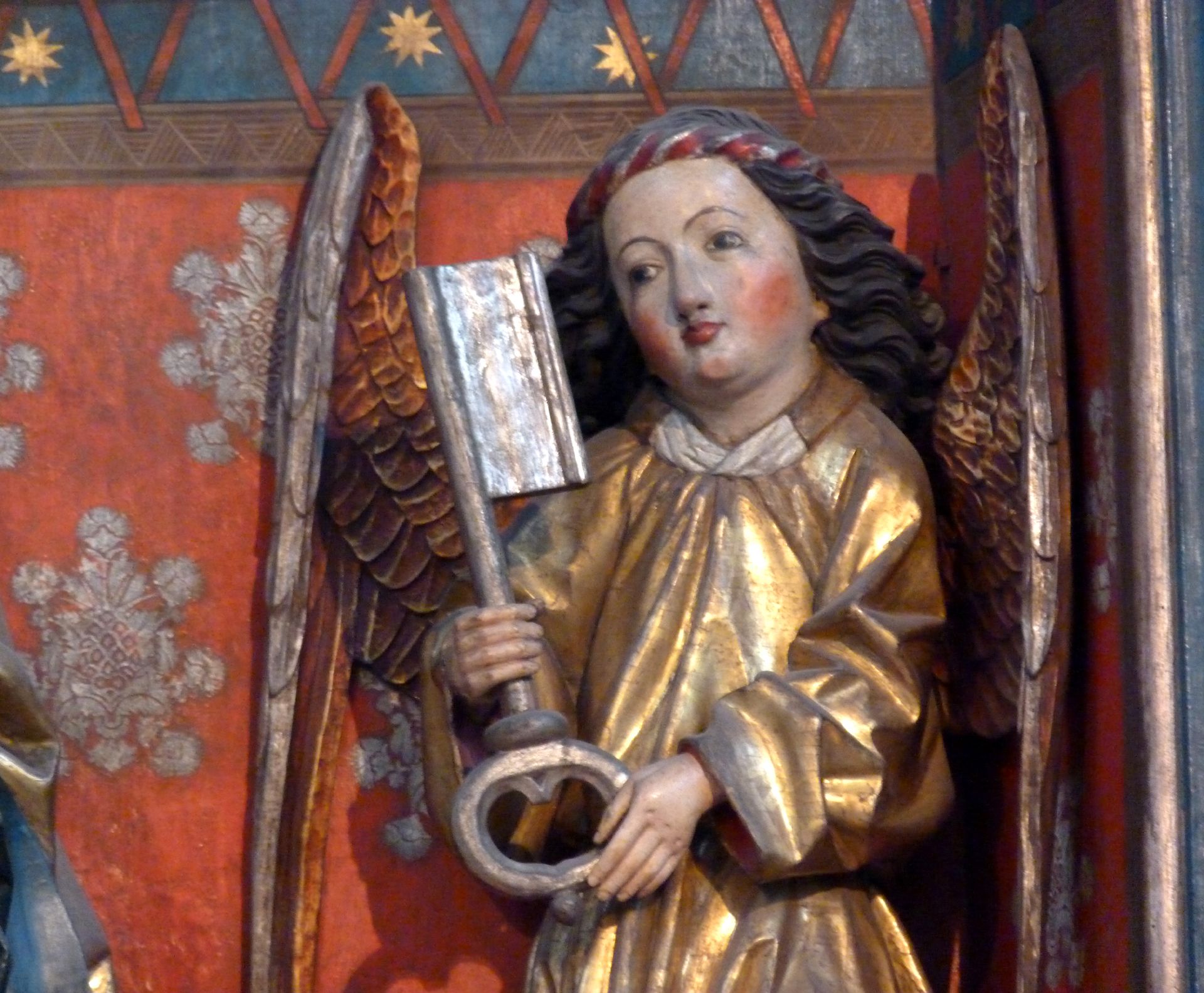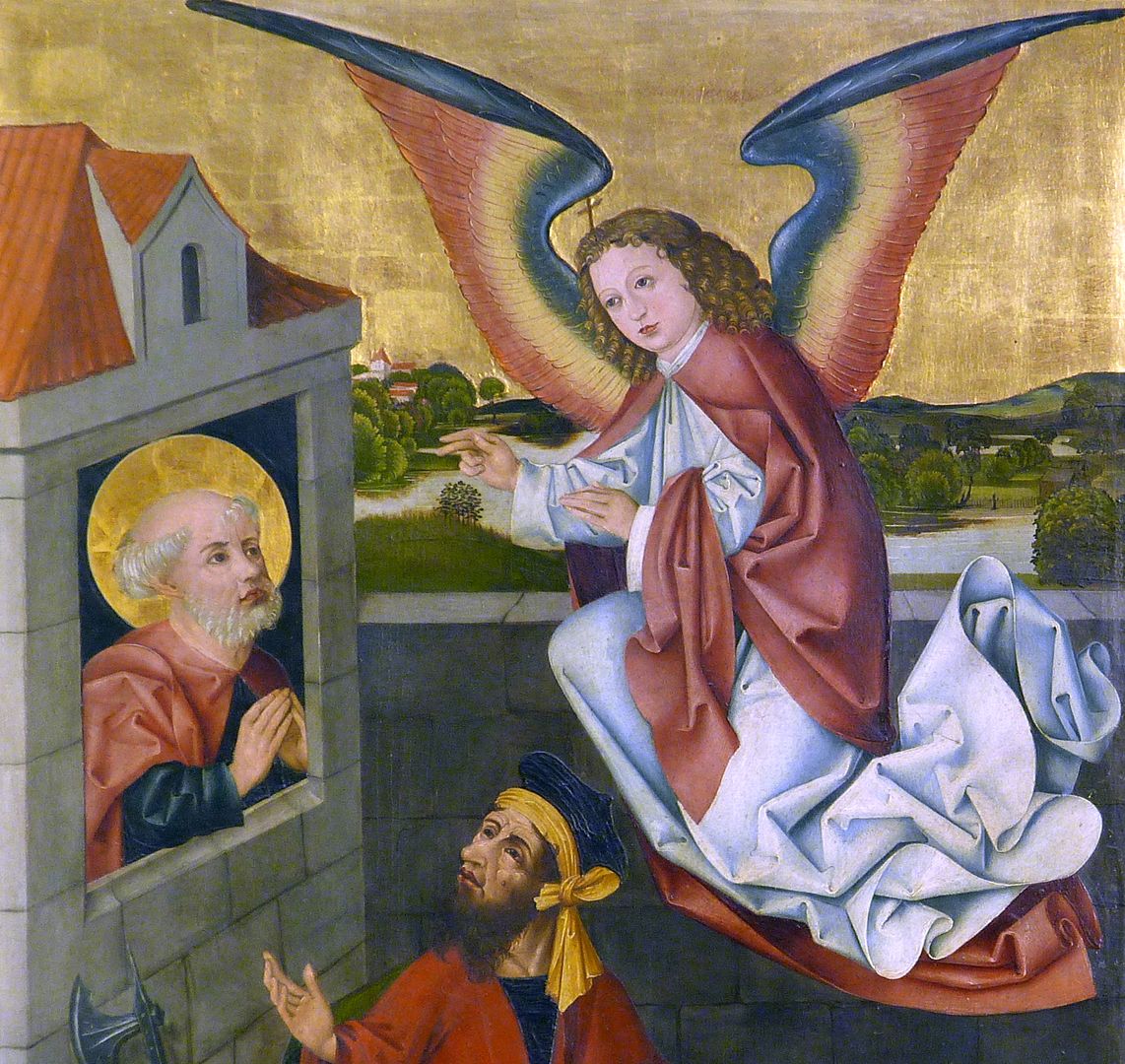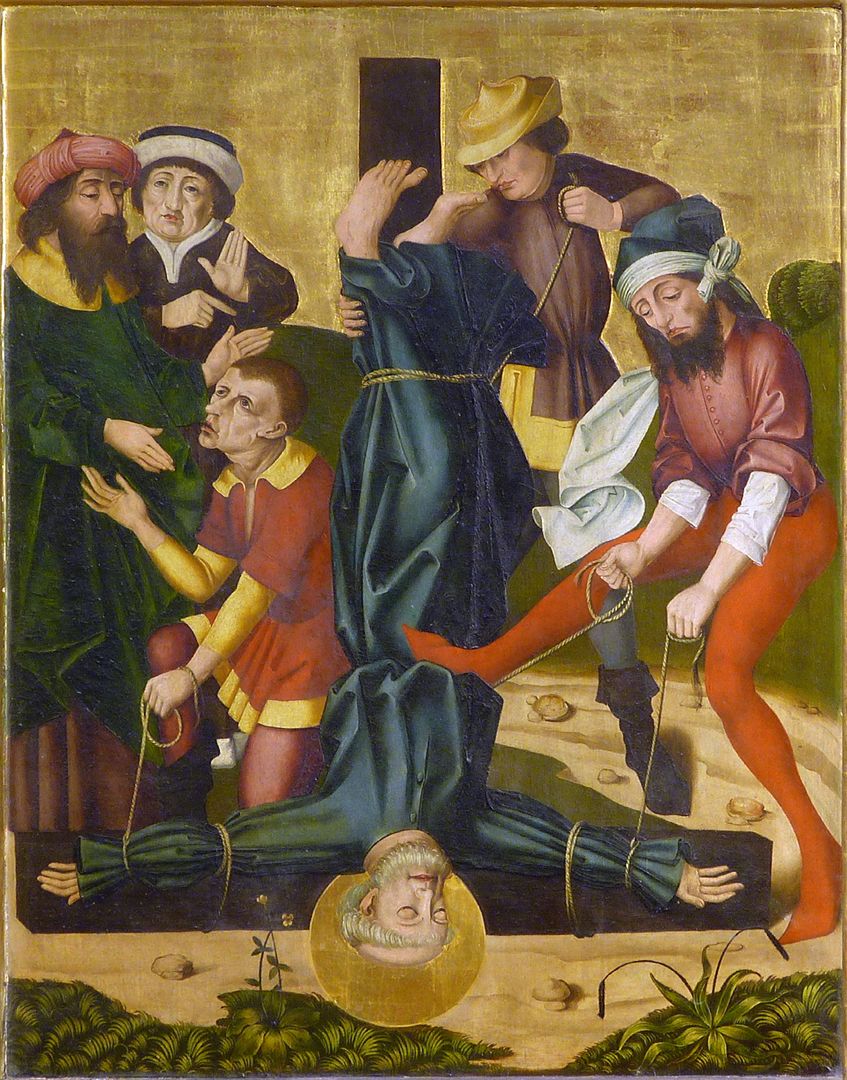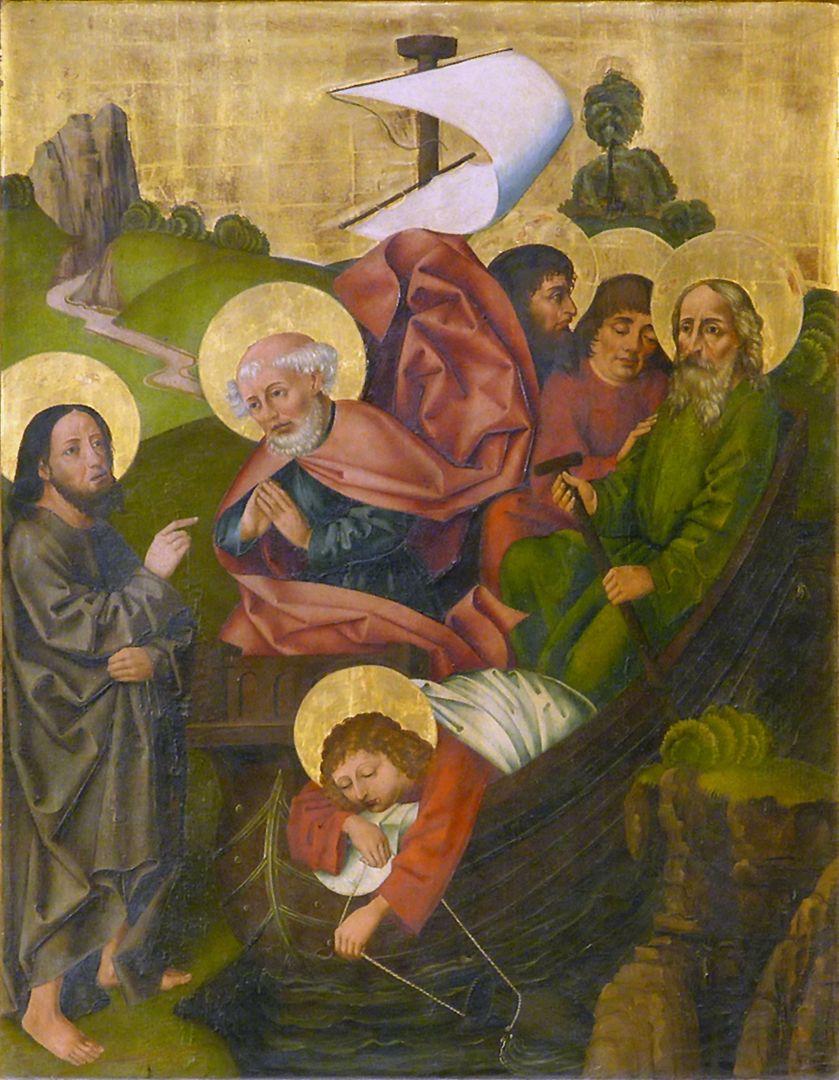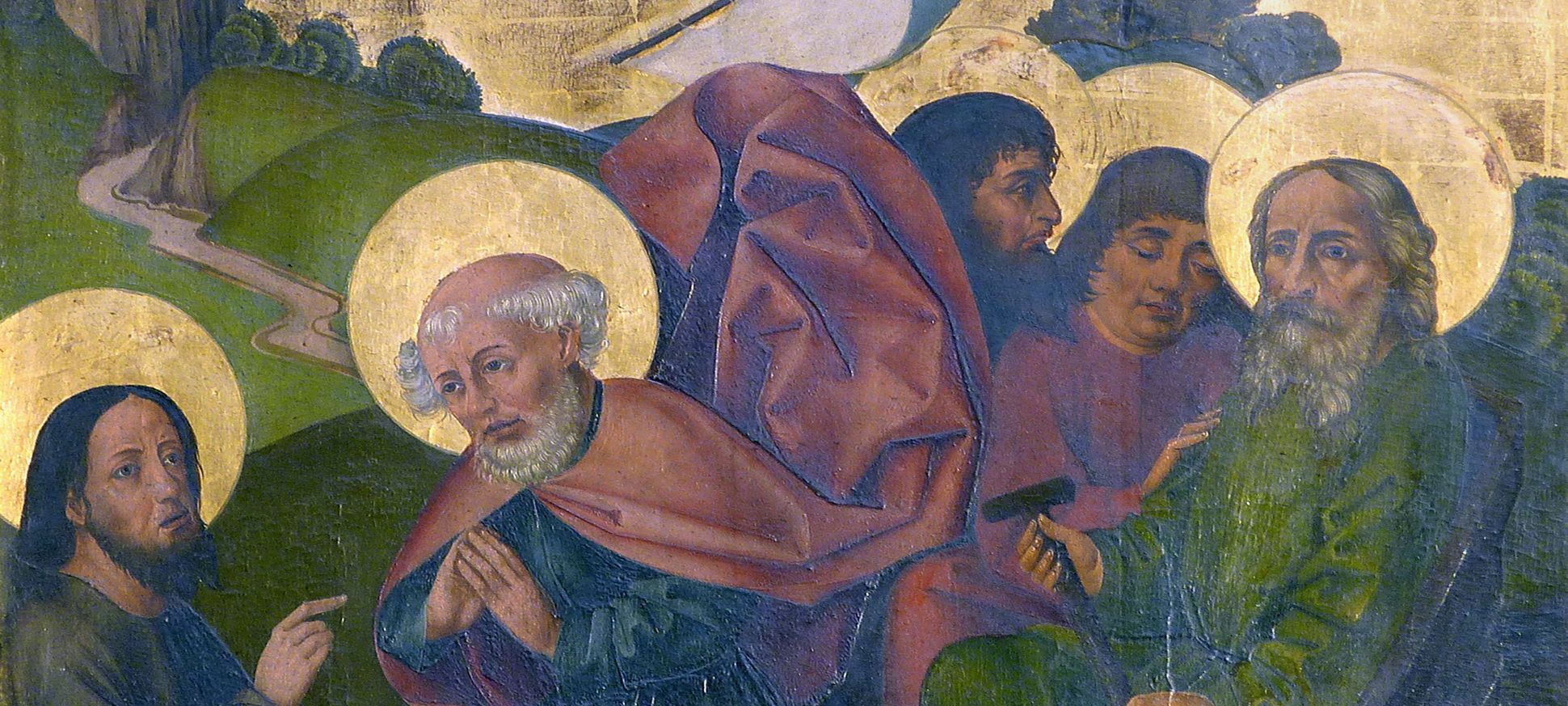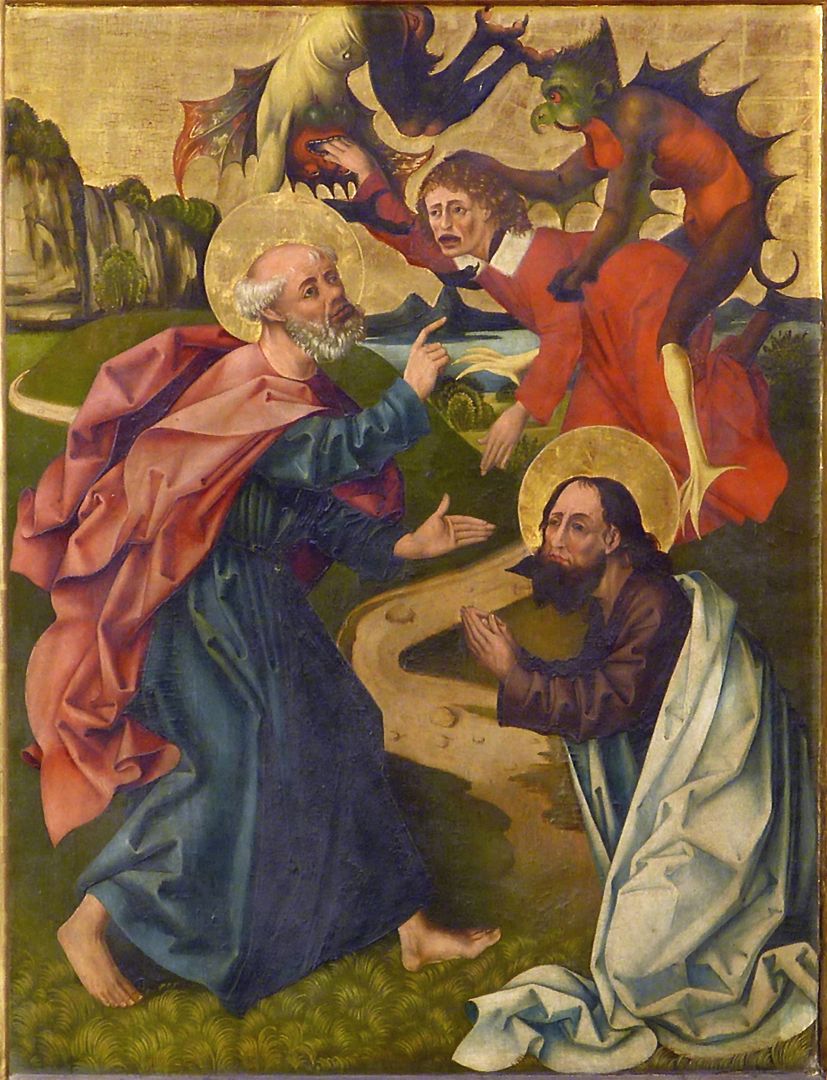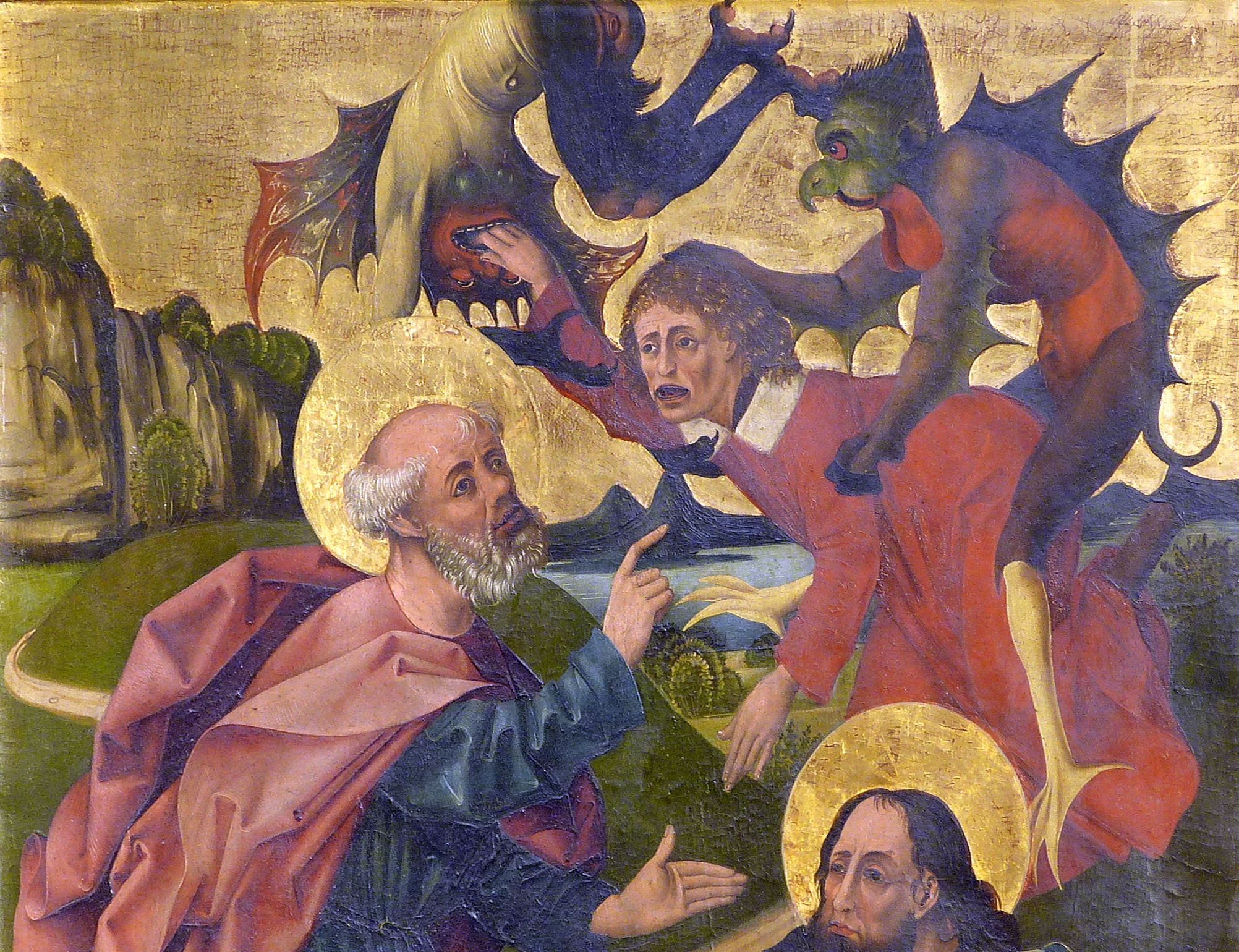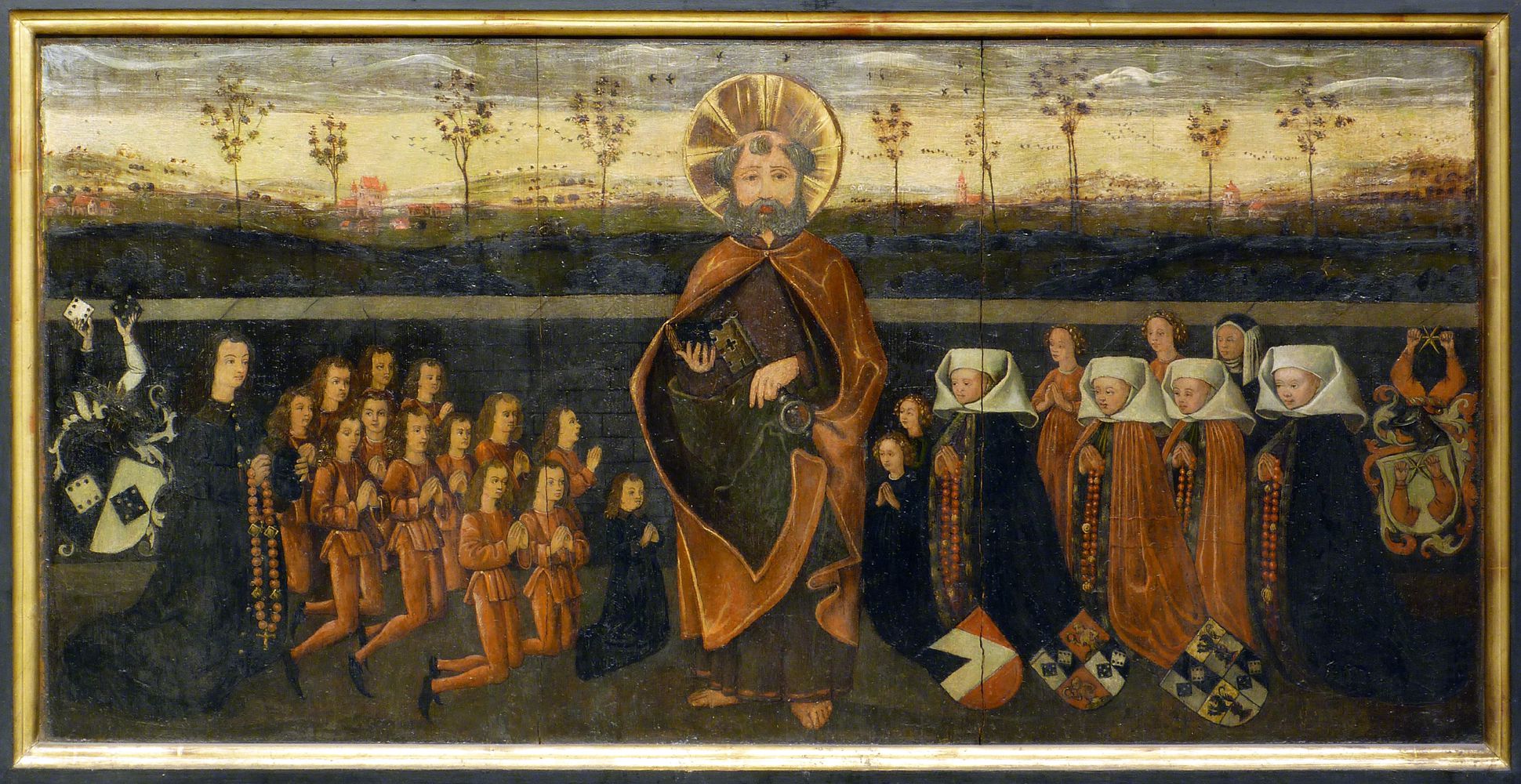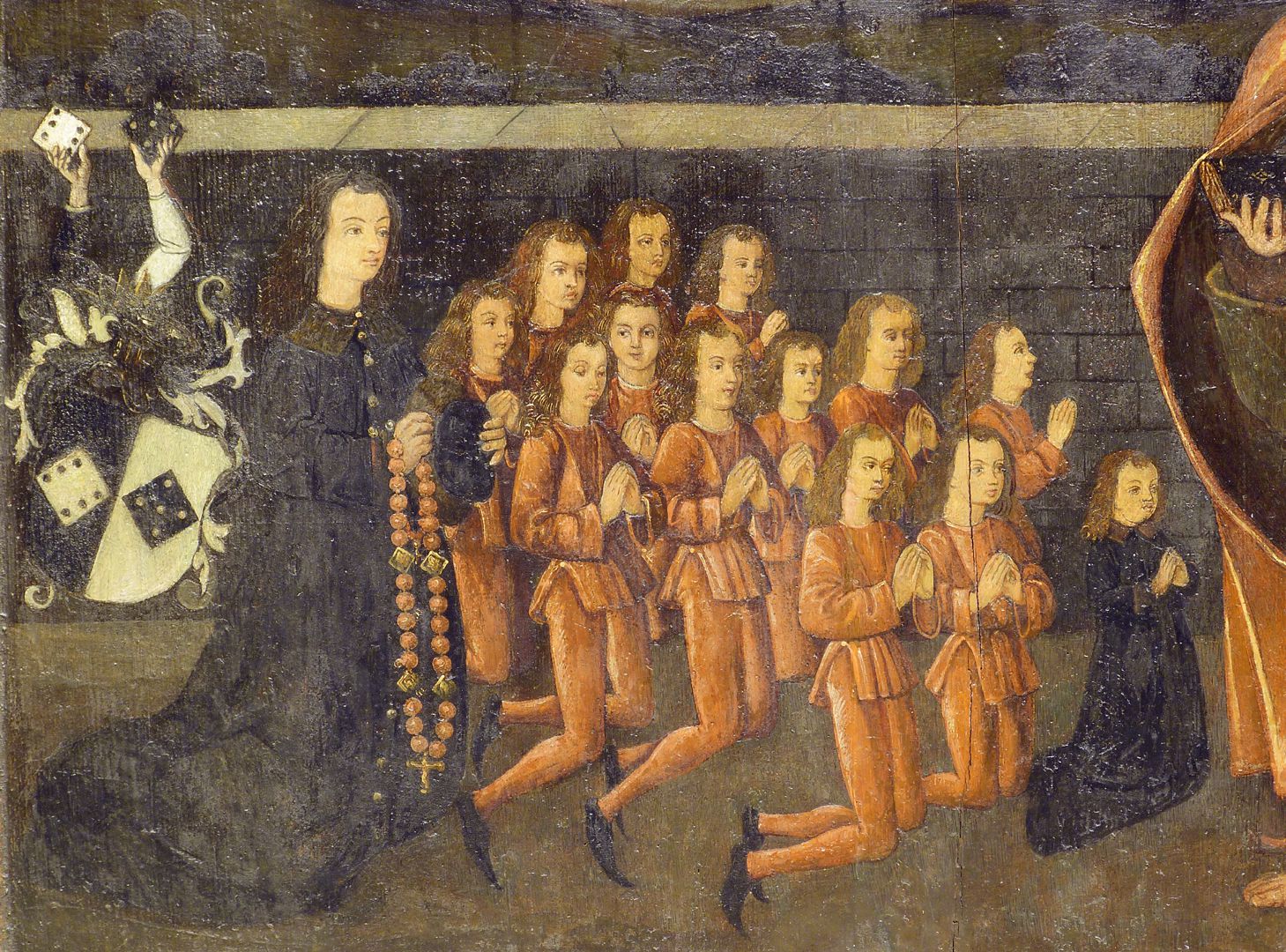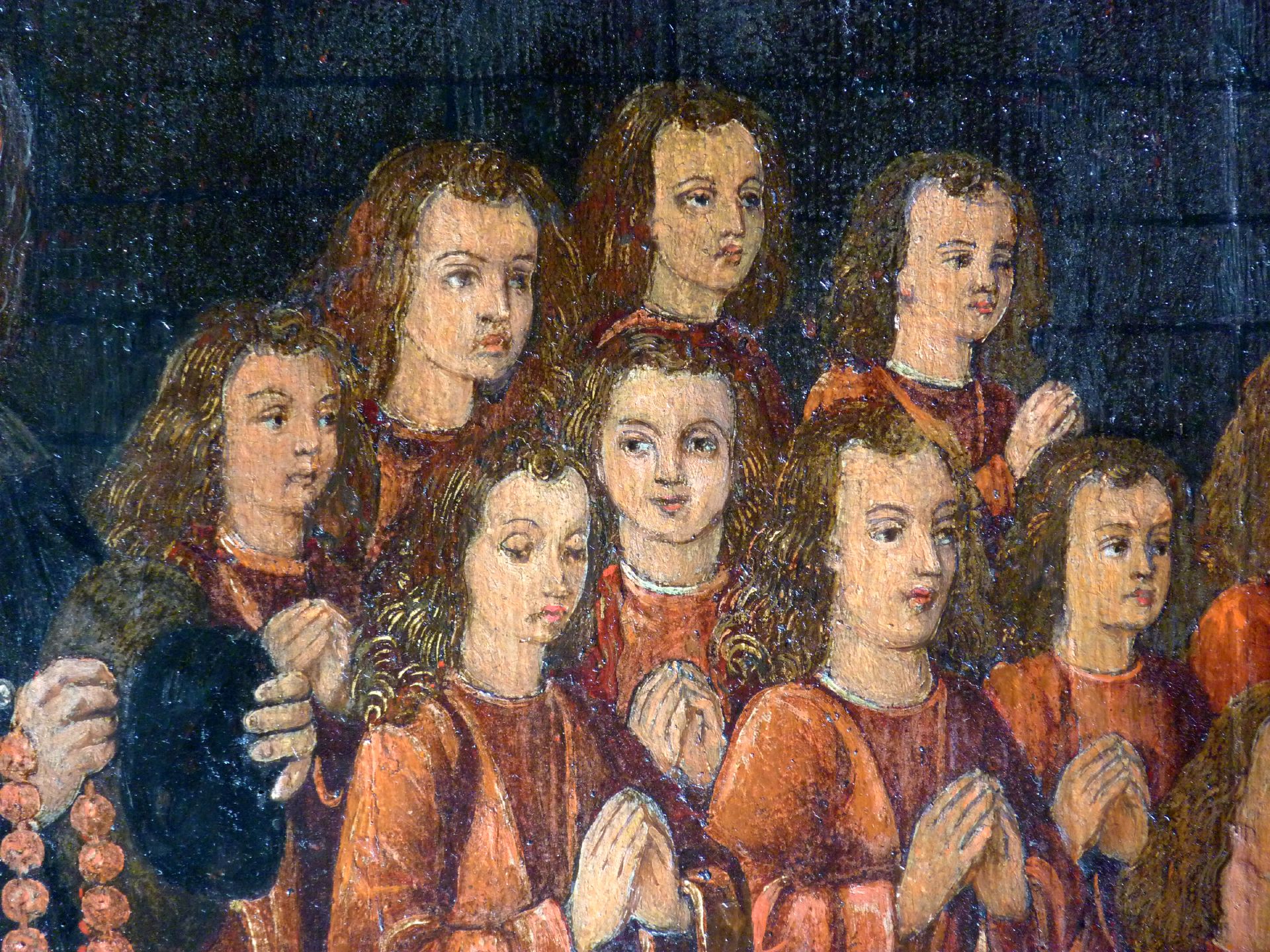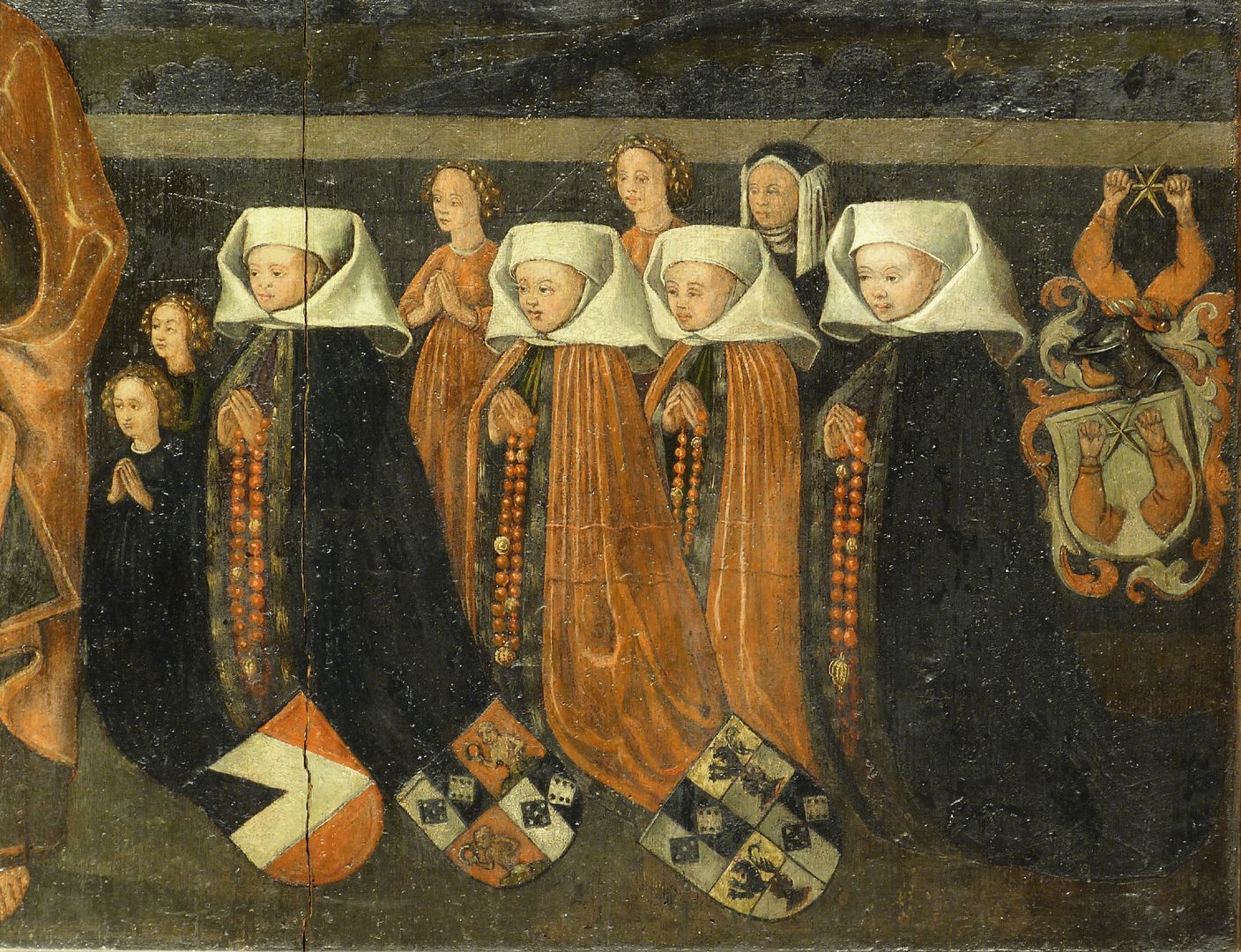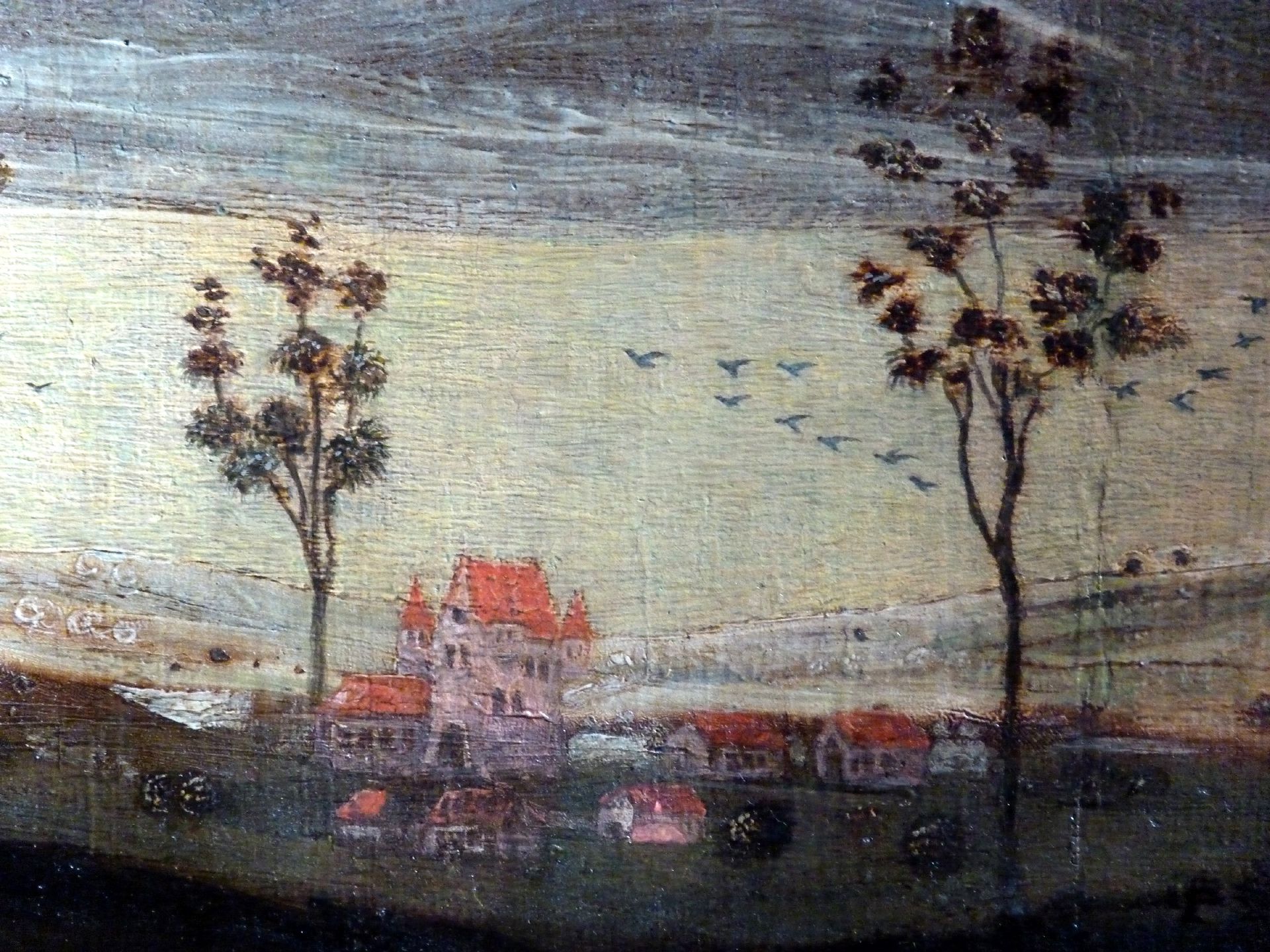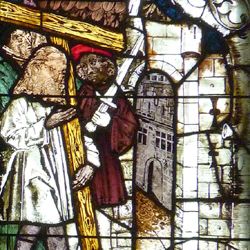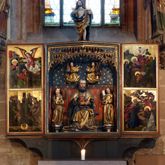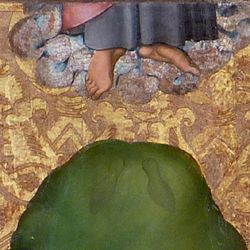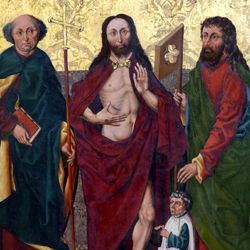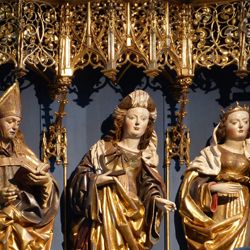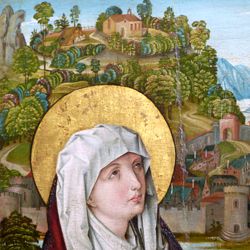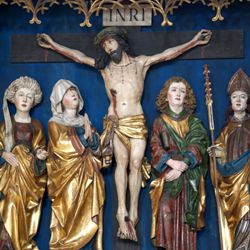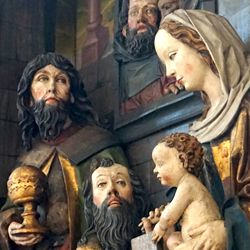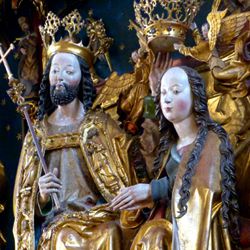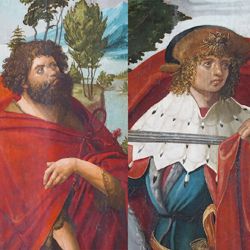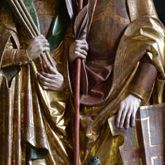Peter´s Altar
Peter´s Altar
ca. 1478
General view without stipes
At the beginning of 1478, St Peter's altar was placed in the choir head of the Sebaldus Church. It corresponds to a sighting from 1476, which has been preserved in the Staatliche Graphische Sammlung in Munich. While the shrine shows carving, the wings were painted (previously attributed to a Nördlingen master). A sprinkling is missing, instead the Risen Christ stands in the central axis above the shrine. No artist's name has survived for this virtuoso work. The altar was donated by Nikolaus Topler. He appears with his family on the altar pendant, while the predella is empty.
The carved figures have been found to have parallels with the master of the Zwickau Marian altar, which according to Stefan Roller were made in the same workshop, cf. Stefan Roller: Nürnberger Bildhauerkunst der Spätgotik: Beiträge zur Skulptur der Reichsstadt in der zweiten Hälfte des 15. Jahrhunderts, Berlin 1999, p. 149.
Dr. Pablo de la Riestra / October 2014
The paintings can be assigned stylistically and in terms of art technology to the Wolgemut workshop. The same painters and sculptors seem to have worked on Wolgemut's Zwickau reredos. In addition, there is clear evidence that working materials (so-called press brocade models) from the same workshop were used on the St Peter's reredos.
see also Zwickau High Altarpiece Retable:
Here we can point to stylistic parallels between the two works.
The sculptures come from the same workshop, as noted by Stefan Roller.
Location: Nuremberg, St. Sebald Church
Realization: Wolgemut, Werkstatt
photo 2014, Theo Noll
Peter´s Altar
ca. 1478
Shrine
At the beginning of 1478, St Peter's altar was placed in the choir head of the Sebaldus Church. It corresponds to a sighting from 1476, which has been preserved in the Staatliche Graphische Sammlung in Munich. While the shrine shows carving, the wings were painted (previously attributed to a Nördlingen master). A sprinkling is missing, instead the Risen Christ stands in the central axis above the shrine. No artist's name has survived for this virtuoso work. The altar was donated by Nikolaus Topler. He appears with his family on the altar pendant, while the predella is empty.
The carved figures have been found to have parallels with the master of the Zwickau Marian altar, which according to Stefan Roller were made in the same workshop, cf. Stefan Roller: Nürnberger Bildhauerkunst der Spätgotik: Beiträge zur Skulptur der Reichsstadt in der zweiten Hälfte des 15. Jahrhunderts, Berlin 1999, p. 149.
Dr. Pablo de la Riestra / October 2014
The paintings can be assigned stylistically and in terms of art technology to the Wolgemut workshop. The same painters and sculptors seem to have worked on Wolgemut's Zwickau reredos. In addition, there is clear evidence that working materials (so-called press brocade models) from the same workshop were used on the St Peter's reredos.
see also Zwickau High Altarpiece Retable:
Here we can point to stylistic parallels between the two works.
The sculptures come from the same workshop, as noted by Stefan Roller.
Location: Nuremberg, St. Sebald Church
Realization: Wolgemut, Werkstatt
photo 2014, Theo Noll
Peter´s Altar
ca. 1478
Shrine, coronation angels (the papal tiara they wore was removed during the Reformation)
photo 2014, Theo Noll
At the beginning of 1478, St Peter's altar was placed in the choir head of the Sebaldus Church. It corresponds to a sighting from 1476, which has been preserved in the Staatliche Graphische Sammlung in Munich. While the shrine shows carving, the wings were painted (previously attributed to a Nördlingen master). A sprinkling is missing, instead the Risen Christ stands in the central axis above the shrine. No artist's name has survived for this virtuoso work. The altar was donated by Nikolaus Topler. He appears with his family on the altar pendant, while the predella is empty.
The carved figures have been found to have parallels with the master of the Zwickau Marian altar, which according to Stefan Roller were made in the same workshop, cf. Stefan Roller: Nürnberger Bildhauerkunst der Spätgotik: Beiträge zur Skulptur der Reichsstadt in der zweiten Hälfte des 15. Jahrhunderts, Berlin 1999, p. 149.
Dr. Pablo de la Riestra / October 2014
The paintings can be assigned stylistically and in terms of art technology to the Wolgemut workshop. The same painters and sculptors seem to have worked on Wolgemut's Zwickau reredos. In addition, there is clear evidence that working materials (so-called press brocade models) from the same workshop were used on the St Peter's reredos.
see also Zwickau High Altarpiece Retable:
Here we can point to stylistic parallels between the two works.
The sculptures come from the same workshop, as noted by Stefan Roller.
Location: Nuremberg, St. Sebald Church
Realization: Wolgemut, Werkstatt
Peter´s Altar
ca. 1478
Shrine, sitting Peter
At the beginning of 1478, St Peter's altar was placed in the choir head of the Sebaldus Church. It corresponds to a sighting from 1476, which has been preserved in the Staatliche Graphische Sammlung in Munich. While the shrine shows carving, the wings were painted (previously attributed to a Nördlingen master). A sprinkling is missing, instead the Risen Christ stands in the central axis above the shrine. No artist's name has survived for this virtuoso work. The altar was donated by Nikolaus Topler. He appears with his family on the altar pendant, while the predella is empty.
The carved figures have been found to have parallels with the master of the Zwickau Marian altar, which according to Stefan Roller were made in the same workshop, cf. Stefan Roller: Nürnberger Bildhauerkunst der Spätgotik: Beiträge zur Skulptur der Reichsstadt in der zweiten Hälfte des 15. Jahrhunderts, Berlin 1999, p. 149.
Dr. Pablo de la Riestra / October 2014
The paintings can be assigned stylistically and in terms of art technology to the Wolgemut workshop. The same painters and sculptors seem to have worked on Wolgemut's Zwickau reredos. In addition, there is clear evidence that working materials (so-called press brocade models) from the same workshop were used on the St Peter's reredos.
see also Zwickau High Altarpiece Retable:
Here we can point to stylistic parallels between the two works.
The sculptures come from the same workshop, as noted by Stefan Roller.
Location: Nuremberg, St. Sebald Church
Realization: Wolgemut, Werkstatt
photo 2014, Theo Noll
Peter´s Altar
ca. 1478
Shrine, left key angel
At the beginning of 1478, St Peter's altar was placed in the choir head of the Sebaldus Church. It corresponds to a sighting from 1476, which has been preserved in the Staatliche Graphische Sammlung in Munich. While the shrine shows carving, the wings were painted (previously attributed to a Nördlingen master). A sprinkling is missing, instead the Risen Christ stands in the central axis above the shrine. No artist's name has survived for this virtuoso work. The altar was donated by Nikolaus Topler. He appears with his family on the altar pendant, while the predella is empty.
The carved figures have been found to have parallels with the master of the Zwickau Marian altar, which according to Stefan Roller were made in the same workshop, cf. Stefan Roller: Nürnberger Bildhauerkunst der Spätgotik: Beiträge zur Skulptur der Reichsstadt in der zweiten Hälfte des 15. Jahrhunderts, Berlin 1999, p. 149.
Dr. Pablo de la Riestra / October 2014
The paintings can be assigned stylistically and in terms of art technology to the Wolgemut workshop. The same painters and sculptors seem to have worked on Wolgemut's Zwickau reredos. In addition, there is clear evidence that working materials (so-called press brocade models) from the same workshop were used on the St Peter's reredos.
see also Zwickau High Altarpiece Retable:
Here we can point to stylistic parallels between the two works.
The sculptures come from the same workshop, as noted by Stefan Roller.
Location: Nuremberg, St. Sebald Church
Realization: Wolgemut, Werkstatt
photo 2014, Theo Noll
Peter´s Altar
ca. 1478
Shrine, right key angel
At the beginning of 1478, St Peter's altar was placed in the choir head of the Sebaldus Church. It corresponds to a sighting from 1476, which has been preserved in the Staatliche Graphische Sammlung in Munich. While the shrine shows carving, the wings were painted (previously attributed to a Nördlingen master). A sprinkling is missing, instead the Risen Christ stands in the central axis above the shrine. No artist's name has survived for this virtuoso work. The altar was donated by Nikolaus Topler. He appears with his family on the altar pendant, while the predella is empty.
The carved figures have been found to have parallels with the master of the Zwickau Marian altar, which according to Stefan Roller were made in the same workshop, cf. Stefan Roller: Nürnberger Bildhauerkunst der Spätgotik: Beiträge zur Skulptur der Reichsstadt in der zweiten Hälfte des 15. Jahrhunderts, Berlin 1999, p. 149.
Dr. Pablo de la Riestra / October 2014
The paintings can be assigned stylistically and in terms of art technology to the Wolgemut workshop. The same painters and sculptors seem to have worked on Wolgemut's Zwickau reredos. In addition, there is clear evidence that working materials (so-called press brocade models) from the same workshop were used on the St Peter's reredos.
see also Zwickau High Altarpiece Retable:
Here we can point to stylistic parallels between the two works.
The sculptures come from the same workshop, as noted by Stefan Roller.
Location: Nuremberg, St. Sebald Church
Realization: Wolgemut, Werkstatt
photo 2014, Theo Noll
Peter´s Altar
ca. 1478
Shrine, left wing above, Peter being comforted in the dungeon by an angel
At the beginning of 1478, St Peter's altar was placed in the choir head of the Sebaldus Church. It corresponds to a sighting from 1476, which has been preserved in the Staatliche Graphische Sammlung in Munich. While the shrine shows carving, the wings were painted (previously attributed to a Nördlingen master). A sprinkling is missing, instead the Risen Christ stands in the central axis above the shrine. No artist's name has survived for this virtuoso work. The altar was donated by Nikolaus Topler. He appears with his family on the altar pendant, while the predella is empty.
The carved figures have been found to have parallels with the master of the Zwickau Marian altar, which according to Stefan Roller were made in the same workshop, cf. Stefan Roller: Nürnberger Bildhauerkunst der Spätgotik: Beiträge zur Skulptur der Reichsstadt in der zweiten Hälfte des 15. Jahrhunderts, Berlin 1999, p. 149.
Dr. Pablo de la Riestra / October 2014
The paintings can be assigned stylistically and in terms of art technology to the Wolgemut workshop. The same painters and sculptors seem to have worked on Wolgemut's Zwickau reredos. In addition, there is clear evidence that working materials (so-called press brocade models) from the same workshop were used on the St Peter's reredos.
see also Zwickau High Altarpiece Retable:
Here we can point to stylistic parallels between the two works.
The sculptures come from the same workshop, as noted by Stefan Roller.
Location: Nuremberg, St. Sebald Church
Realization: Wolgemut, Werkstatt
photo 2019, Theo Noll
Peter´s Altar
ca. 1478
Shrine, left wing above, comforting Peter in the dungeon by an angel, detail
At the beginning of 1478, St Peter's altar was placed in the choir head of the Sebaldus Church. It corresponds to a sighting from 1476, which has been preserved in the Staatliche Graphische Sammlung in Munich. While the shrine shows carving, the wings were painted (previously attributed to a Nördlingen master). A sprinkling is missing, instead the Risen Christ stands in the central axis above the shrine. No artist's name has survived for this virtuoso work. The altar was donated by Nikolaus Topler. He appears with his family on the altar pendant, while the predella is empty.
The carved figures have been found to have parallels with the master of the Zwickau Marian altar, which according to Stefan Roller were made in the same workshop, cf. Stefan Roller: Nürnberger Bildhauerkunst der Spätgotik: Beiträge zur Skulptur der Reichsstadt in der zweiten Hälfte des 15. Jahrhunderts, Berlin 1999, p. 149.
Dr. Pablo de la Riestra / October 2014
The paintings can be assigned stylistically and in terms of art technology to the Wolgemut workshop. The same painters and sculptors seem to have worked on Wolgemut's Zwickau reredos. In addition, there is clear evidence that working materials (so-called press brocade models) from the same workshop were used on the St Peter's reredos.
see also Zwickau High Altarpiece Retable:
Here we can point to stylistic parallels between the two works.
The sculptures come from the same workshop, as noted by Stefan Roller.
Location: Nuremberg, St. Sebald Church
Realization: Wolgemut, Werkstatt
photo 2019, Theo Noll
Peter´s Altar
ca. 1478
Shrine, left wing down, crucifixion of Peter
At the beginning of 1478, St Peter's altar was placed in the choir head of the Sebaldus Church. It corresponds to a sighting from 1476, which has been preserved in the Staatliche Graphische Sammlung in Munich. While the shrine shows carving, the wings were painted (previously attributed to a Nördlingen master). A sprinkling is missing, instead the Risen Christ stands in the central axis above the shrine. No artist's name has survived for this virtuoso work. The altar was donated by Nikolaus Topler. He appears with his family on the altar pendant, while the predella is empty.
The carved figures have been found to have parallels with the master of the Zwickau Marian altar, which according to Stefan Roller were made in the same workshop, cf. Stefan Roller: Nürnberger Bildhauerkunst der Spätgotik: Beiträge zur Skulptur der Reichsstadt in der zweiten Hälfte des 15. Jahrhunderts, Berlin 1999, p. 149.
Dr. Pablo de la Riestra / October 2014
The paintings can be assigned stylistically and in terms of art technology to the Wolgemut workshop. The same painters and sculptors seem to have worked on Wolgemut's Zwickau reredos. In addition, there is clear evidence that working materials (so-called press brocade models) from the same workshop were used on the St Peter's reredos.
see also Zwickau High Altarpiece Retable:
Here we can point to stylistic parallels between the two works.
The sculptures come from the same workshop, as noted by Stefan Roller.
Location: Nuremberg, St. Sebald Church
Realization: Wolgemut, Werkstatt
photo 2019, Theo Noll
Peter´s Altar
ca. 1478
Shrine, right wing above, Calling of Peter
At the beginning of 1478, St Peter's altar was placed in the choir head of the Sebaldus Church. It corresponds to a sighting from 1476, which has been preserved in the Staatliche Graphische Sammlung in Munich. While the shrine shows carving, the wings were painted (previously attributed to a Nördlingen master). A sprinkling is missing, instead the Risen Christ stands in the central axis above the shrine. No artist's name has survived for this virtuoso work. The altar was donated by Nikolaus Topler. He appears with his family on the altar pendant, while the predella is empty.
The carved figures have been found to have parallels with the master of the Zwickau Marian altar, which according to Stefan Roller were made in the same workshop, cf. Stefan Roller: Nürnberger Bildhauerkunst der Spätgotik: Beiträge zur Skulptur der Reichsstadt in der zweiten Hälfte des 15. Jahrhunderts, Berlin 1999, p. 149.
Dr. Pablo de la Riestra / October 2014
The paintings can be assigned stylistically and in terms of art technology to the Wolgemut workshop. The same painters and sculptors seem to have worked on Wolgemut's Zwickau reredos. In addition, there is clear evidence that working materials (so-called press brocade models) from the same workshop were used on the St Peter's reredos.
see also Zwickau High Altarpiece Retable:
Here we can point to stylistic parallels between the two works.
The sculptures come from the same workshop, as noted by Stefan Roller.
Location: Nuremberg, St. Sebald Church
Realization: Wolgemut, Werkstatt
photo 2019, Theo Noll
Peter´s Altar
ca. 1478
Shrine, right wing above, calling of Peter, detail with heads
photo 2019, Theo Noll
At the beginning of 1478, St Peter's altar was placed in the choir head of the Sebaldus Church. It corresponds to a sighting from 1476, which has been preserved in the Staatliche Graphische Sammlung in Munich. While the shrine shows carving, the wings were painted (previously attributed to a Nördlingen master). A sprinkling is missing, instead the Risen Christ stands in the central axis above the shrine. No artist's name has survived for this virtuoso work. The altar was donated by Nikolaus Topler. He appears with his family on the altar pendant, while the predella is empty.
The carved figures have been found to have parallels with the master of the Zwickau Marian altar, which according to Stefan Roller were made in the same workshop, cf. Stefan Roller: Nürnberger Bildhauerkunst der Spätgotik: Beiträge zur Skulptur der Reichsstadt in der zweiten Hälfte des 15. Jahrhunderts, Berlin 1999, p. 149.
Dr. Pablo de la Riestra / October 2014
The paintings can be assigned stylistically and in terms of art technology to the Wolgemut workshop. The same painters and sculptors seem to have worked on Wolgemut's Zwickau reredos. In addition, there is clear evidence that working materials (so-called press brocade models) from the same workshop were used on the St Peter's reredos.
see also Zwickau High Altarpiece Retable:
Here we can point to stylistic parallels between the two works.
The sculptures come from the same workshop, as noted by Stefan Roller.
Location: Nuremberg, St. Sebald Church
Realization: Wolgemut, Werkstatt
Peter´s Altar
ca. 1478
Right wing below, Peter and Paul overcoming the magician Simon
At the beginning of 1478, St Peter's altar was placed in the choir head of the Sebaldus Church. It corresponds to a sighting from 1476, which has been preserved in the Staatliche Graphische Sammlung in Munich. While the shrine shows carving, the wings were painted (previously attributed to a Nördlingen master). A sprinkling is missing, instead the Risen Christ stands in the central axis above the shrine. No artist's name has survived for this virtuoso work. The altar was donated by Nikolaus Topler. He appears with his family on the altar pendant, while the predella is empty.
The carved figures have been found to have parallels with the master of the Zwickau Marian altar, which according to Stefan Roller were made in the same workshop, cf. Stefan Roller: Nürnberger Bildhauerkunst der Spätgotik: Beiträge zur Skulptur der Reichsstadt in der zweiten Hälfte des 15. Jahrhunderts, Berlin 1999, p. 149.
Dr. Pablo de la Riestra / October 2014
The paintings can be assigned stylistically and in terms of art technology to the Wolgemut workshop. The same painters and sculptors seem to have worked on Wolgemut's Zwickau reredos. In addition, there is clear evidence that working materials (so-called press brocade models) from the same workshop were used on the St Peter's reredos.
see also Zwickau High Altarpiece Retable:
Here we can point to stylistic parallels between the two works.
The sculptures come from the same workshop, as noted by Stefan Roller.
Location: Nuremberg, St. Sebald Church
Realization: Wolgemut, Werkstatt
photo 2019, Theo Noll
Peter´s Altar
ca. 1478
Right wing below, Peter and Paul overcoming the magician Simon, upper half of the picture
At the beginning of 1478, St Peter's altar was placed in the choir head of the Sebaldus Church. It corresponds to a sighting from 1476, which has been preserved in the Staatliche Graphische Sammlung in Munich. While the shrine shows carving, the wings were painted (previously attributed to a Nördlingen master). A sprinkling is missing, instead the Risen Christ stands in the central axis above the shrine. No artist's name has survived for this virtuoso work. The altar was donated by Nikolaus Topler. He appears with his family on the altar pendant, while the predella is empty.
The carved figures have been found to have parallels with the master of the Zwickau Marian altar, which according to Stefan Roller were made in the same workshop, cf. Stefan Roller: Nürnberger Bildhauerkunst der Spätgotik: Beiträge zur Skulptur der Reichsstadt in der zweiten Hälfte des 15. Jahrhunderts, Berlin 1999, p. 149.
Dr. Pablo de la Riestra / October 2014
The paintings can be assigned stylistically and in terms of art technology to the Wolgemut workshop. The same painters and sculptors seem to have worked on Wolgemut's Zwickau reredos. In addition, there is clear evidence that working materials (so-called press brocade models) from the same workshop were used on the St Peter's reredos.
see also Zwickau High Altarpiece Retable:
Here we can point to stylistic parallels between the two works.
The sculptures come from the same workshop, as noted by Stefan Roller.
Location: Nuremberg, St. Sebald Church
Realization: Wolgemut, Werkstatt
photo 2019, Theo Noll
Peter´s Altar
ca. 1478
Antependium vor dem Stipes: St. Petrus mit dem Stifter Nikolaus Topler und seiner Familie. Topler war in erster Ehe mit der aus Zwickau stammenden Martha, geborene Truhenschmidt (begraben 3.5.1467) und in zweiter mit Clara, geborene Haller verheiratet
photo 2019, Theo Noll
At the beginning of 1478, St Peter's altar was placed in the choir head of the Sebaldus Church. It corresponds to a sighting from 1476, which has been preserved in the Staatliche Graphische Sammlung in Munich. While the shrine shows carving, the wings were painted (previously attributed to a Nördlingen master). A sprinkling is missing, instead the Risen Christ stands in the central axis above the shrine. No artist's name has survived for this virtuoso work. The altar was donated by Nikolaus Topler. He appears with his family on the altar pendant, while the predella is empty.
The carved figures have been found to have parallels with the master of the Zwickau Marian altar, which according to Stefan Roller were made in the same workshop, cf. Stefan Roller: Nürnberger Bildhauerkunst der Spätgotik: Beiträge zur Skulptur der Reichsstadt in der zweiten Hälfte des 15. Jahrhunderts, Berlin 1999, p. 149.
Dr. Pablo de la Riestra / October 2014
The paintings can be assigned stylistically and in terms of art technology to the Wolgemut workshop. The same painters and sculptors seem to have worked on Wolgemut's Zwickau reredos. In addition, there is clear evidence that working materials (so-called press brocade models) from the same workshop were used on the St Peter's reredos.
see also Zwickau High Altarpiece Retable:
Here we can point to stylistic parallels between the two works.
The sculptures come from the same workshop, as noted by Stefan Roller.
Location: Nuremberg, St. Sebald Church
Realization: Wolgemut, Werkstatt
Peter´s Altar
ca. 1478
Antependium, detailed view with the sons of Nicolaus Topler to the right of Peter
At the beginning of 1478, St Peter's altar was placed in the choir head of the Sebaldus Church. It corresponds to a sighting from 1476, which has been preserved in the Staatliche Graphische Sammlung in Munich. While the shrine shows carving, the wings were painted (previously attributed to a Nördlingen master). A sprinkling is missing, instead the Risen Christ stands in the central axis above the shrine. No artist's name has survived for this virtuoso work. The altar was donated by Nikolaus Topler. He appears with his family on the altar pendant, while the predella is empty.
The carved figures have been found to have parallels with the master of the Zwickau Marian altar, which according to Stefan Roller were made in the same workshop, cf. Stefan Roller: Nürnberger Bildhauerkunst der Spätgotik: Beiträge zur Skulptur der Reichsstadt in der zweiten Hälfte des 15. Jahrhunderts, Berlin 1999, p. 149.
Dr. Pablo de la Riestra / October 2014
The paintings can be assigned stylistically and in terms of art technology to the Wolgemut workshop. The same painters and sculptors seem to have worked on Wolgemut's Zwickau reredos. In addition, there is clear evidence that working materials (so-called press brocade models) from the same workshop were used on the St Peter's reredos.
see also Zwickau High Altarpiece Retable:
Here we can point to stylistic parallels between the two works.
The sculptures come from the same workshop, as noted by Stefan Roller.
Location: Nuremberg, St. Sebald Church
Realization: Wolgemut, Werkstatt
photo 2019, Theo Noll
Peter´s Altar
ca. 1478
Antependium, detail with the sons of Nikolaus Topler to the right of Peter, detail
At the beginning of 1478, St Peter's altar was placed in the choir head of the Sebaldus Church. It corresponds to a sighting from 1476, which has been preserved in the Staatliche Graphische Sammlung in Munich. While the shrine shows carving, the wings were painted (previously attributed to a Nördlingen master). A sprinkling is missing, instead the Risen Christ stands in the central axis above the shrine. No artist's name has survived for this virtuoso work. The altar was donated by Nikolaus Topler. He appears with his family on the altar pendant, while the predella is empty.
The carved figures have been found to have parallels with the master of the Zwickau Marian altar, which according to Stefan Roller were made in the same workshop, cf. Stefan Roller: Nürnberger Bildhauerkunst der Spätgotik: Beiträge zur Skulptur der Reichsstadt in der zweiten Hälfte des 15. Jahrhunderts, Berlin 1999, p. 149.
Dr. Pablo de la Riestra / October 2014
The paintings can be assigned stylistically and in terms of art technology to the Wolgemut workshop. The same painters and sculptors seem to have worked on Wolgemut's Zwickau reredos. In addition, there is clear evidence that working materials (so-called press brocade models) from the same workshop were used on the St Peter's reredos.
see also Zwickau High Altarpiece Retable:
Here we can point to stylistic parallels between the two works.
The sculptures come from the same workshop, as noted by Stefan Roller.
Location: Nuremberg, St. Sebald Church
Realization: Wolgemut, Werkstatt
photo 2014, Theo Noll
Peter´s Altar
ca. 1478
Antependium, women's side to the left of Peter. Nikolaus Topler was married in his first marriage to Martha, née Truhenschmidt (buried 3.5.1467) from Zwickau and in his second marriage to Clara, née Haller.
At the beginning of 1478, St Peter's altar was placed in the choir head of the Sebaldus Church. It corresponds to a sighting from 1476, which has been preserved in the Staatliche Graphische Sammlung in Munich. While the shrine shows carving, the wings were painted (previously attributed to a Nördlingen master). A sprinkling is missing, instead the Risen Christ stands in the central axis above the shrine. No artist's name has survived for this virtuoso work. The altar was donated by Nikolaus Topler. He appears with his family on the altar pendant, while the predella is empty.
The carved figures have been found to have parallels with the master of the Zwickau Marian altar, which according to Stefan Roller were made in the same workshop, cf. Stefan Roller: Nürnberger Bildhauerkunst der Spätgotik: Beiträge zur Skulptur der Reichsstadt in der zweiten Hälfte des 15. Jahrhunderts, Berlin 1999, p. 149.
Dr. Pablo de la Riestra / October 2014
The paintings can be assigned stylistically and in terms of art technology to the Wolgemut workshop. The same painters and sculptors seem to have worked on Wolgemut's Zwickau reredos. In addition, there is clear evidence that working materials (so-called press brocade models) from the same workshop were used on the St Peter's reredos.
see also Zwickau High Altarpiece Retable:
Here we can point to stylistic parallels between the two works.
The sculptures come from the same workshop, as noted by Stefan Roller.
Location: Nuremberg, St. Sebald Church
Realization: Wolgemut, Werkstatt
photo 2019, Theo Noll
Peter´s Altar
ca. 1478
Antependium, detail view of the background with a Nuremberg (Toplersches?) pond house
At the beginning of 1478, St Peter's altar was placed in the choir head of the Sebaldus Church. It corresponds to a sighting from 1476, which has been preserved in the Staatliche Graphische Sammlung in Munich. While the shrine shows carving, the wings were painted (previously attributed to a Nördlingen master). A sprinkling is missing, instead the Risen Christ stands in the central axis above the shrine. No artist's name has survived for this virtuoso work. The altar was donated by Nikolaus Topler. He appears with his family on the altar pendant, while the predella is empty.
The carved figures have been found to have parallels with the master of the Zwickau Marian altar, which according to Stefan Roller were made in the same workshop, cf. Stefan Roller: Nürnberger Bildhauerkunst der Spätgotik: Beiträge zur Skulptur der Reichsstadt in der zweiten Hälfte des 15. Jahrhunderts, Berlin 1999, p. 149.
Dr. Pablo de la Riestra / October 2014
The paintings can be assigned stylistically and in terms of art technology to the Wolgemut workshop. The same painters and sculptors seem to have worked on Wolgemut's Zwickau reredos. In addition, there is clear evidence that working materials (so-called press brocade models) from the same workshop were used on the St Peter's reredos.
see also Zwickau High Altarpiece Retable:
Here we can point to stylistic parallels between the two works.
The sculptures come from the same workshop, as noted by Stefan Roller.
Location: Nuremberg, St. Sebald Church
Realization: Wolgemut, Werkstatt
photo 2014, Theo Noll


